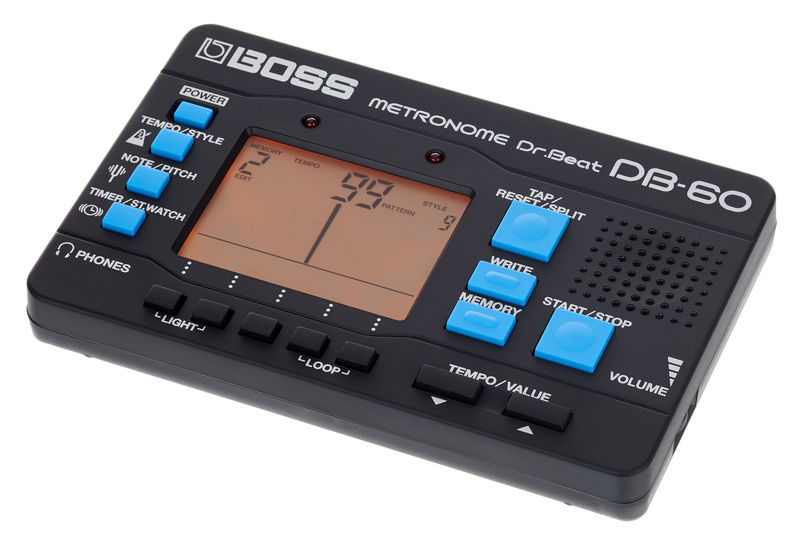The Versatile and Professional Dr. BeatPractice in style with the flagship of the Dr.
Beat Metronome line. The new DB-90 is loaded with quality sounds and drum patterns to make your practice sessions less mundane and more musical. Better Beats, Better PracticeThe Note Mixing function allows you to instantly create a variety ofbeats by adjusting the levels of five different note values. Front-panel sliders, buttons, and a large rotary dial provide instant, hands-on access to edit parameters. Select four different click sounds, including a human voice-counting sound that will help you know your place in the bar. The DB-90 is also equipped with realistic PCM drum patterns, for developing your accuracy and rhythmic feel effectively.
Plug Into Rhythm CoachExpand your rhythmic horizons with Rhythm Coach. This innovative follow-along feature has four training modes to help build your accuracy, speed, and endurance.
With the DB-90’s onboard microphone, you can use the Rhythm Coach functions with acoustic drums, or plug a Roland V-Pad into the Trigger input. Play along, and chart your progress. Many UsesDrummers can connect to the DB-90 via Roland V-Pads or the internal microphone. Guitarist and bassist can directly plug into the DB-90 without any other gear required, and monitor via connected headphones — practically any type of instrumentalist can benefit from the DB-90’s features.

And for those who wish to sync to an external sequencer for more elaborate accompaniment, they can do so with the DB-90’s MIDI input. This stage-oriented feature is especially useful for drummers.
I to get either a drum machine or a metronome as a portable tool for learning new rhythms. After a bit of research, I realised almost all drum machines don't take batteries. So I have to rule them out and now dig a bit deeper into DB-60 and DB-90.
Boss Dr Beat Db- 88 Manual
What I need is rhythm programming. I downloaded their manuals to see if they do what I want. But the manuals aren't really helpful.So, here are my questions:- I don't understand the difference between the terms 'Styles', 'Beats' and 'Rhythms' used in the manuals.- The manuals say available beats are: 1-9, 2+3, 3+2, etc etc.

What do those '1-9', '2+3' mean? I thought '2+3' means claves. But later the manuals talk about clave rhythm as a separate thing. Very confusing.- DB-60 manual says volumes can be set at 3 different levels.
So, including muting, are there actually 4 levels?- It seems volumes can only be changed in Beats, not in Rhythms?- Can I program it to do a simple rhythm like this?Thanks. The manuals say available beats are: 1-9, 2+3, 3+2, etc etc. What do those '1-9', '2+3' mean?
I thought '2+3' means claves. But later the manuals talk about clave rhythm as a separate thing.
Very confusing.' Beats' are time-signatures or the number of beats per measure or bar. For example if you wanted to practice in 5/4 you could choose beat '5' OR 2+3 or 3+2 which is simply sub-dividing the time signature (or beat) of 5 for a different feel. Try counting 1-2-3-4-5, 1-2-3-4-5, etc out loud at the same tempo. Now count 1-2-1-2-3, 1-2-1-2-3 in the same fashion. Both are in 5, but with a different feel.
You can subdivide other odd time signatures like 7 (3+4, 4+3), 9 (4+5, 5+4), and so on.' Rhythms' are specific patterns or grooves like 'Funk', 'Shuffle', Blues, etc.
3-2 OR 2-3 Clave refer to how a specific latin rhythm is played over two measures, usually in 4/4 or c (common) time. For example a 3-2 Rumba Clave:For a 2-3 Clave, you would simply reverse the bars.